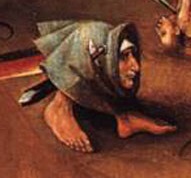Gryllus
From The Art and Popular Culture Encyclopedia

|
Gryllus: "Let us begin with the virtues, which, we note, inspire you with pride ; for you rate yourselves as far superior to animals in justice and wisdom and courage and all the rest of them."--"Beasts Are Rational" by Plutarch |
|
Related e |
|
Featured: |
Gryllus is a genus of crickets.
In mythology and in visual culture
Gryllus (plural grylli) is pig in Greek and cricket in Latin. (Marina Warner, Monsters of Our Own Making).
In Plutarch's Moralia, Gryllus is one of Circe's victims who preferred to stay a pig after his transformation. This episode is known as "Ulysses and Gryllus". Lorenzo Valla, Michel de Montaigne and many others commented upon this episode, see "reasoning beasts".
Another ancient writer who mentions gryllus is Pliny the Elder in his Natural History. He uses the word gryllus for a class of grotesque figures first used in painting by Antiphilus of Alexandria: "he painted a figure in a ridiculous costume, known jocosely as the Gryllus; and hence it is that pictures of this class are generally known as "Grylli."
The history of the grylli has received its most in-depth study in Marina Warner's Monsters of Our Own Making. In another of Warner's books, No Go the Bogeyman, illustrations of grylli are depicted throughout the book, taken from Les Heures de Thérouanne, a thirteenth century manuscript, drawn by hand in Le moyen âge fantastique by Jurgis Baltrusaitis (Paris, 1955).[1]
The book Images, Texts, and Marginalia in a "Vows of the Peacock" by Domenic Leo gives a taxonomic vocabulary of hybrids in which the gryllus is one element:
- "I am using terminology proposed by Sandler, “Reflections on the Construction of Hybrids,” and Jurgis Baltrušaitis, Le moyen âge fantastique. The rudimentary taxonomic vocabulary for hybrids is as follows: bifurcated (head as center with two bodies), gryllus (body with no torso: head replaces genitals), pushmepullu (one body with a head emerging from each side), and composite (hybrids created from multiple parts)."
In Pliny the Elder
- "idem iocoso nomine Gryllym deridiculi habitus pinxit, unde id genus pictura grylli vocantur."
English:
- "he painted a figure in a ridiculous costume, known jocosely as the Gryllus; and hence it is that pictures of this class are generally known as "Grylli."
See also
- Gryllus detail from Bosch's Triptych of the Temptation of St. Anthony [2]
- Grotesque art
- Ulysses and Gryllus, a dialogue found in Plutarch's Moralia
- Excerpt on grylli in the The Lewis Collection of Gems and Rings in the Possession of Corpus Christi

